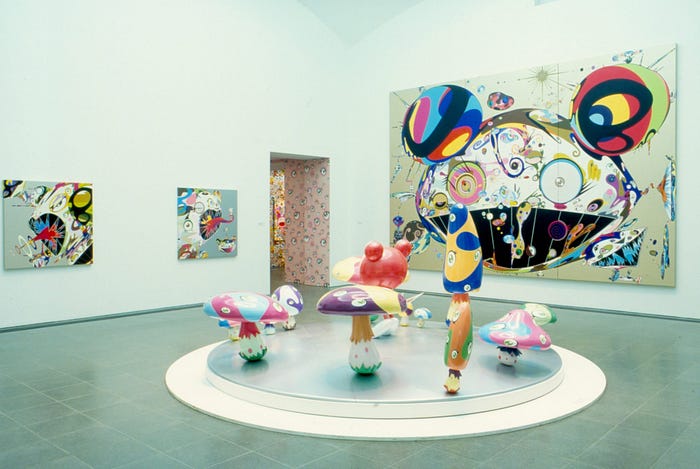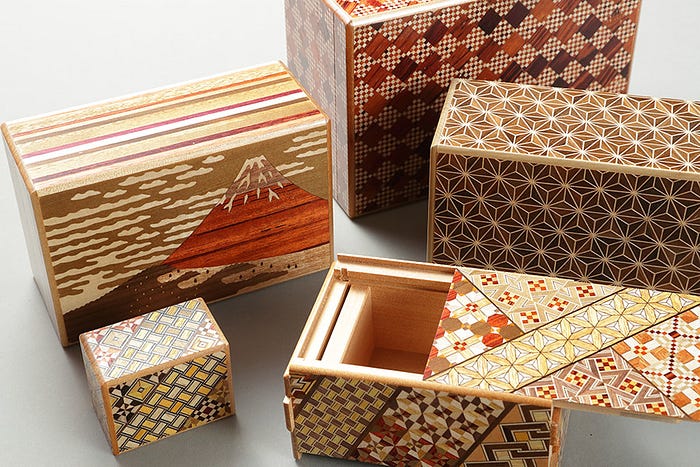Why creativity flourishes in Japan
Posted on 2022-11-07 in art
·5 min read
Over the last 2 decades, the creativity I’ve come across in Japan repeatedly induces awe and wonder and tickles my brain. Manga, anime, games, music, movies, shows, ads, architecture, paintings, installations, fashion, funky commercial products… one favorite of mine is art by Takashi Murakami.

(Source: https://www.serpentinegalleries.org/whats-on/takashi-murakami-kaikai-kiki/)
There are several reasons why creativity flourishes:
Lots of people with spare money and time
Japan has the 3rd highest GDP and, among OECD countries, the 3rd highest population (used to be 2nd in both). With efficient and reliable infrastructure, healthy food, and minimal crime, people can focus on their creative work.
Heavy exposure to both Eastern and Western culture and arts
Japan has been influenced heavily by China, US, Europe, etc. over centuries. Not to mention Japan itself has had a vibrant art/culture scene since over 1000 years ago. The Western influence accelerated due to the Meiji Restoration of 1868 and the US occupation post-WW2. Even today, there are a huge number of e.g. French culture fanatics/hobbyists in Japan. The culture of appreciation for the arts (esp. Western and Japanese) is deeply ingrained now, as can be seen in the numerous excellent museums.
It’s also notable that the Japanese language is extremely flexible/expressive and includes almost all Chinese concepts/characters while also using a huge number of loan words from English, French, German, etc. In practice, 4 writing systems are usually used simultaneously (kanji, hiragana, katakana, and the English alphabet).
Metropolitan areas as creative hubs
Greater Tokyo is the world’s largest metropolitan area, with ~37 million people. (Osaka is ranked 10th). By riding in one of the world’s best public transport systems, any of those 37M people can easily meet up and share their ideas, paintings, clothes, robots, etc. whether at a huge event like Tokyo Game Show or a tiny informal meetup over beers. Even if you are into some weird, long-tail, obscure topic, such as crafting 19th century French maid costumes, you can probably find at least a few people among that 37M to explore that topic with. Of course, video conferencing and COVID affect how much this matters, but I’d say physical interaction still matters hugely in terms of communication, exchanging ideas, and creating meaningful outlets for creative expression.
Manga publishing industry practices
In Japan, it has been possible since about 50 years ago for a single creator with no track record and no money to test his/her creative ideas on a large population.
The typical example of this is an aspiring manga artist submitting a couple pages to the editors of a weekly/monthly manga magazine such as Shonen Jump, which can choose to include those pages (along with manga by other artsits) in the weekly issue. The marginal cost is almost zero (there’s just opportunity cost of not including another artist’s work). If reader feedback is good, the next chapter can be included the next week as well, and perhaps the author could be on their way to fame and fortune. (This process was depicted/dramatized in BAKUMAN, a manga/movie about publishing manga.) Then, if the manga really takes off, companies like Bandai Namco skillfully kick the monetization into high gear with shows/movies, toys, clothes, games, etc. and all that money feeds back into making the creative industry stronger.
This rapid, low-cost trial and error of creative ideas on a huge readership is the equivalent of having tons of people throw tons of ideas on the wall and quickly seeing which ones stick. Contrast this to most countries, where it often takes a creator’s track record and maybe some special connections (to e.g. a publishing company or a movie studio) and a significant commitment of budget to get creative material in front of a large audience.
The culture of manga/anime has become deeply ingrained over decades, so it’s normal for the average adult in Japan to enjoy such content, whereas in some countries, most cartoons are considered to be mostly for kids, limiting the industry potential.
Granted, the internet has provided new avenues of reaching audiences, so perhaps the Japanese advantage is not as big anymore, but I’d argue that it’s hard for a given piece of online content to gain traction/virality in the vast ocean of content without creative industry pros supporting it, so the Japanese manga/anime/IP industrial complex is still an important differentiator for Japan.
Speaking of the internet, it has been a major way for the fandom of Japanese manga/anime fandom to blossom globally, and there has been an explosion of Japan-inspired cartoons, games, fan art, NFTs, etc. made by non-Japanese people.
Openness to metaverses / NFTs
In contrast to some countries, where there is considerable pushback from regulators and gaming communities on the use of NFTs, people in Japan are mostly open to the use of NFTs, and the Japanese government is increasingly pro-NFT / pro-Web3 as well. This unlocks new ways for creators to be rewarded and engage with communities. The idea of virtual non-human characters and virtual worlds is also familiar to most Japanese people, partially due to the gaming/anime/otaku culture and mainstream content such as the excellent Mamoru Hosoda metaverse movies Summer Wars and Belle. Also, virtual Youtubers have taken off in Japan like nowhere else (the most famous one, Kizuna AI, has over 3M subscribers). Probably this metaverse/NFT-friendly environment is one reason why metaverse giant Animoca Brands was able to raise $45M at a $500M valuation for its Japan branch.
(screenshot from the movie Belle)
“Shokunin” spirit
Shokunin (職人) means “artisan” or “craftsman”. To embody the shokunin spirit as a creator is to take great pride in one’s work and mastery of it, even the tiny, menial details. More explanation here. Although this can arguably be in some ways detrimental to creativity (e.g. spend years perfecting how to cut sushi perfectly à la Jiro Dreams of Sushi rather than experimenting with new sushi dishes), in some other ways the shokunin attitude and mastery can lead to unique creative works that are quite hard for replicate due to the unique degree and combination of skills required. For example, yosegi-zaiku (寄木細工), a type of Japanese marquetry, which is basically combining pieces of wood, sounds simple but damn I bet it’s hard to execute:

(Source: https://www.yosegi.jp/)
Stay tuned
Next I will post about the past and future of creative/generative AI in Japan. Feel free to subscribe or follow me at https://twitter.com/peacej ♫